Il Rio Doce è morto, per sempre Racconto della Chernobyl brasiliana

Il Rio Doce è morto, la sua biodiversità azzerata, alcune delle specie endemiche che lo popolavano perse per sempre. A dirlo è National Geographic, che in un recente articolo racconta l’immensa tragedia ecologica di uno dei fiumi più importanti del Brasile e di tutto il Sudamerica. Il Rio Doce attraversa, con i suoi 853 chilometri di lunghezza, gli stati di Minas Gerais ed Espirito Santo, nel Sud-Est del Brasile, e si getta poi nelle acque dell’Oceano Atlantico. E proprio nel grande mare sono arrivati i fanghi tossici fuoriusciti dal crollo di un bacino di lagunaggio nel Minas Gerais il 5 novembre, creando un disastro ambientale senza precedenti e a cui ora porre rimedio è sempre più complicato.
«Il fiume è arancione, migliaia di pesci galleggiano sulla superficie. Gamberi e chiocciole d’acqua dolce fuggono il loro ambiente naturale per finire agonizzanti sulla riva, alla ricerca di una impossibile salvezza. I galleggianti a protezione delle sponde e i fossati scavati dall’esercito per deviare lo tsunami di fanghi tossici non sono bastati a evitare la catastrofe»: sono queste le conseguenze del cedimento del bacino di lagunaggio Fundão situato a Mariana, cittadina del Minas Gerais nei pressi di Belo Horizonte. Tutto ha avuto inizio nel pomeriggio del 5 novembre, quando, durante i lavori di ampliamento della vasca, il crollo di una parete ha provocato lo sversamento di ben 62 milioni di metri cubi di fanghi tossici e acque acide di origine mineraria nella sottostante valle di Santarém. Anche il piccolo villaggio di Bento Rodrigues, composto da operai che lavorano nelle vicine miniere e situato a 2,5 chilometri di distanza, è stato completamente travolto e distrutto. I soccorritori hanno potuto raggiungere la popolazione locale solamente con gli elicotteri, essendo Bento Rodrigues completamente isolato. La gente è stata poi trasportata nella vicina città di Mariana.

In this Nov. 24, 2015 photo, Danielle Savy, member of the animal protection group Forca Animal, works to coax a dog out of a mudslide damaged home, in Paracatu, Brazil. After obliterating the town, the tide of mud and debris surged forward, blanketing a wide swath of land and cascading into the Doce River, leaving behind the dazed survivors. (AP Photo/Leo Correa)
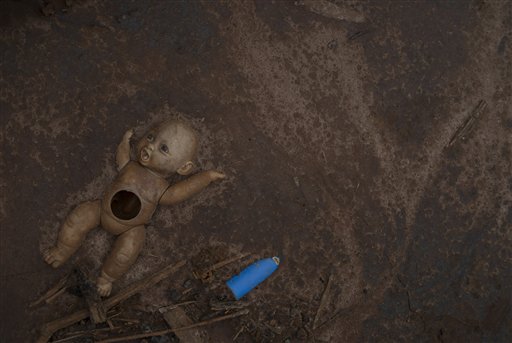
In this Nov. 24, 2015 photo, a doll lies embedded in a layer of mud in Paracatu, Brazil. Thirteen people died in the tragedy, and another 11 remain missing. (AP Photo/Leo Correa)
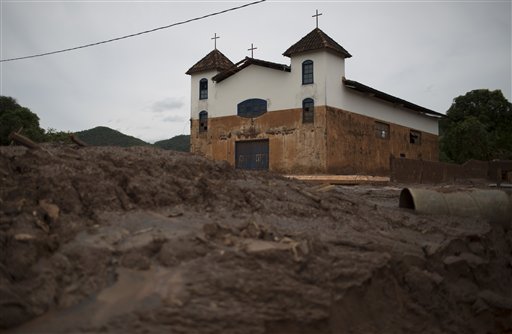
In this Nov. 24, 2015 photo, the color brown on the church's white walls indicate the level which water and mud reached during a recent mudslide triggered by the failing of a dam at a nearby iron ore mine, in Paracatu, Brazil. After the disaster hit, the hamlet of Paracatu and other nearby hamlets like Bento Rodrigues became ghost towns. (AP Photo/Leo Correa)

This Nov. 24, 2015 photo, shows the destruction of the hamlet of Paracatu, Brazil, caused by an early November mudslide, triggered by the failing of a dam at a nearby iron ore mine. Now the area is a mud-slathered no-go-zones where there are few reminders of the lives people built here. (AP Photo/Leo Correa)

This Nov. 23, 2015 photo shows debris awash in mud in Bento Rodrigues, Brazil. After obliterating several towns, the tide of mud and debris surged forward, blanketing a wide swath of land and cascading into the Doce River. (AP Photo/Leo Correa)

In this Nov. 23, 2015 photo, a car sits precariously on top of the wall of a home, destroyed when the dam of an iron ore mine burst in early November, causing a mudslide, in Bento Rodrigues, Brazil. Thirteen people died in the tragedy, and another 11 remain missing. (AP Photo/Leo Correa)
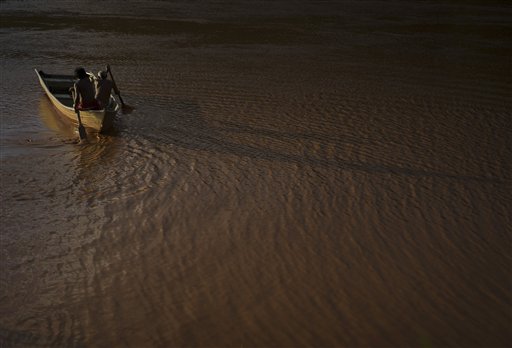
In this Nov. 22, 2015 photo, Ererre, left center, and Jose Cecilio Damasceno, both of the Krenak people, row their boat on the Doce River, polluted by a mix of residues from a dam that burst in early November, in Resplendor, Minas Gerais state, Brazil. The disaster threatens their traditional way of life as an indigenous people who live along the Doce River. (AP Photo/Leo Correa)
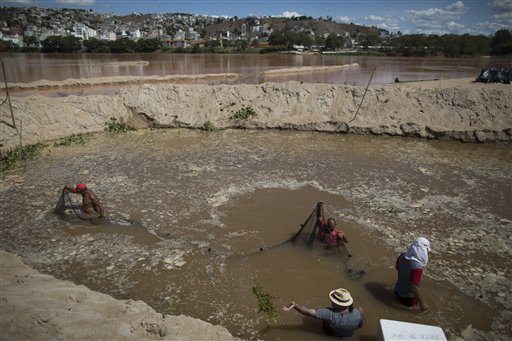
In this Nov. 21, 2015 photo, fishermen use a net in a temporary pool they built to protect some of the creatures that inhabit the Doce River from polluted waters, in Colatina, Brazil. The plume of mud released by the Samarco mine dam disaster, devastated wildlife, despite efforts by local fisherman and others to move fish out of the contaminated waters. (AP Photo/Leo Correa)
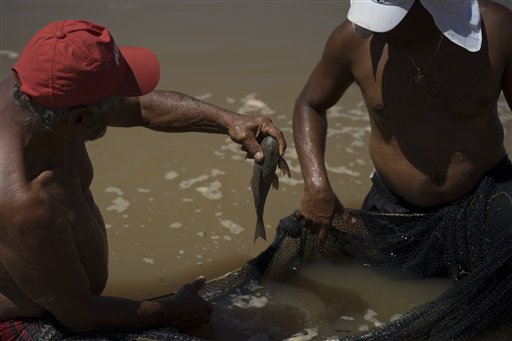
In this Nov. 21, 2015 photo, a fisherman holds a fish over a net in a temporary pool built to protect some of the creatures that inhabit the Doce River from polluted waters, in Colatina, Brazil. Even though the fishermen claim to have rescued at least 110 species from the polluted waters, nearly a month after the dam burst, the effects of the disaster at the Samarco iron ore mine continue to affect wildlife. (AP Photo/Leo Correa)

In this Nov. 21, 2015 photo, Thiago Palassi collects a cup of water from the Doce River, in Colatina, Brazil. The flood of mud unleashed by the dam burst at the Samarco mine all but erased a nearby hamlet. The wave spilled into the Doce River, where it has devastated fish and other wildlife and compromised the source of drinking water for hundreds of thousands of people. (AP Photo/Leo Correa)

A woman with her face covered with clay, lies on the sidewalk during a protest against the Brazilian mining company Vale, in Rio de Janeiro, Brazil, Monday, Nov. 16, 2015. The demonstrators demand that the company take responsibility for the damage caused by two dams that burst at its iron ore mine, that wiped out a village in the southeastern state of Minas Gerais. (AP Photo/Leo Correa)
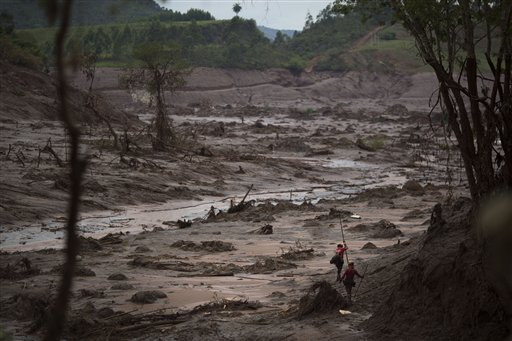
In this Sunday, Nov. 8, 2015 photo, rescue workers search for victims at the site where the town of Bento Rodrigues stood, after two dams burst on Nov. 5, in the state of Minas Gerais, Brazil. Search and rescue teams say they have found the bodies of six victims of the mud tide, while another 19 people remain missing. The mudflow continued through the week, eventually reaching a key river, where it has devastated wildlife and threatened the drinking water supply for hundreds of thousands of people downstream. (AP Photo/Felipe Dana)
Dalla valle di Santarém, l’onda di fango s’è presto riversata prima nel Rio Carmo e successivamente nel ben più grande e importante Rio Doce. È iniziata così la lunga e tragica corsa verso l’Atlantico dei fanghi tossici, giunti a destinazione 25 giorni e 600 chilometri dopo. Come spiega National Geographic, il volume di fanghi tossici fuoriusciti della Samarco è di due volte e mezzo superiore a quelli fuoriusciti l’anno scorso dalla miniera canadese di Mount Polley, in quella che finora era considerata la più grave contaminazione ambientale mai avvenuta sulla terraferma. A lasciare di stucco il mondo intero è stata l’incapacità di reagire a una simile tragedia sia da parte della Samarco Mineração, società titolare della concessione estrattiva e dimostratasi priva di un protocollo d’emergenza per simili evenienze, sia del governo brasiliano, che nonostante l’operazione rinominata “Arca di Noè”, si è trovato a dover fare i conti con un bilancio (provvisorio) di 9 morti, 19 dispersi e 600 sfollati.

A woman spreads clay over the logo of the Brazilian mining company Vale at the entrance of the company building, in Rio de Janeiro, Brazil, Monday, Nov. 16, 2015. The demonstrators demand that the company take responsibility for the damage caused by two dams that burst at its iron ore mine, that wiped out a village in the southeastern state of Minas Gerais. (AP Photo/Leo Correa)

A woman with her face covered with clay, lies on the street during a protest against the Brazilian mining company Vale, in Rio de Janeiro, Brazil, Monday, Nov. 16, 2015. The demonstrators demand that the company take responsibility for the damage caused by two dams that burst at its iron ore mine, that wiped out a village in the southeastern state of Minas Gerais. (AP Photo/Leo Correa)

Demonstrators perform during a protest against the Brazilian mining company Vale, in Rio de Janeiro, Brazil, Monday, Nov. 16, 2015. The demonstrators demand that the company take responsibility for the damage caused by two dams that burst at its iron ore mine, that wiped out a village in the southeastern state of Minas Gerais. (AP Photo/Leo Correa)

People perform during a protest against the Brazilian mining company Vale, in Rio de Janeiro, Brazil, Monday, Nov. 16, 2015. The demonstrators demand that the company take responsibility for the damage caused by two dams that burst at its iron ore mine, that wiped out a village in the southeastern state of Minas Gerais. (AP Photo/Leo Correa)
L’economia di tutta l’area della Minas Gerais, come suggerisce il nome stesso, è fondata sull’enorme ricchezza del sottosuolo. L’attività estrattiva che si compie in questa regione rappresenta più della metà di quella di tutto il Brasile. Proprio qui, nel 1942, venne fondata la Companhia Vale do Rio Doce, colosso internazionale nel settore dell’estrazione ed esportazione di ossidi di ferro. La Samarco, azienda che ha causato questa immane tragedia, è per metà di proprietà proprio della Vale, ma non è controllata da questa: dietro alla Samarco, infatti, ci sarebbe la BHP Billiton, società anglo-australiana leader mondiale del settore minerario. Eppure tutta la pressione dei media nazionali e internazionali, che hanno parlato di «Fukushima brasiliana» o di «Chernobyl verdeoro», è stata tutta diretta verso la Vale. La quale s’è trovata alla fine costretta, dopo le iniziali smentite, ad ammettere la fuoriuscita dei fanghi. Vania Somavilla, direttore esecutivo dell’ufficio comunicazione di Vale, ha però escluso la presenza di metalli tossici nello tsunami di fango che ha travolto il Rio Doce. Le sue affermazioni sono state presto smentite dalle analisi condotte in diversi punti del fiume dall’Istituto di Gestione delle Acque del Minas Gerais, le quali hanno evidenziato concentrazioni record di metalli tossici: il piombo risultava 165 volte superiore al limite legale, l’arsenico 108 volte, il rame 75 e il cromo 57.

Oltre alla Vale, i media si sono scagliati anche contro a Dilma Rousseff, presidente della Repubblica, accusata di non essere stata in grado di affrontare la questione con rapidità. La Rousseff, pochi giorni dopo il disastro, ha annunciato l’avvio di un piano di recupero a lungo termine del Rio Doce e di tutta l’area circostante, peccato che per fare in modo che la situazione torni ad essere almeno simile a com’era prima del 5 novembre bisognerà attendere, nelle più rosee aspettative, 10 anni. Troppi per la popolazione indigena, che non solo riteneva sacro il Rio Doce, ma soprattutto viveva grazie ad esso. Nel frattempo il governo ha comunque dato il via a una causa civile da 5,3 miliardi di dollari contro Samarco, Vale e BHP Billiton, destinati a creare un fondo per aiutare gli sforzi di recupero del fiume. Intanto la Samarco è stata multata per 250 milioni di euro: poca roba per un’azienda che ha alle spalle colossi dal fatturato a nove zeri. E una cifra, soprattutto, che non ripristinerà la biodiversità del fiume, persa probabilmente per sempre.
Intanto lo tsunami di fango non è ancora stato fermato: riversatosi nell’Atlantico, in poche ore ha coperto circa 70 chilometri di pescose coste dell’Espirito Santo. Ora si teme che i venti possano spingere l’onda arancione fino alle acque della riserva naturale delle isole Abrolhos, creando un nuovo disastro, questa volta anche turistico. E il mondo osserva, impotente.